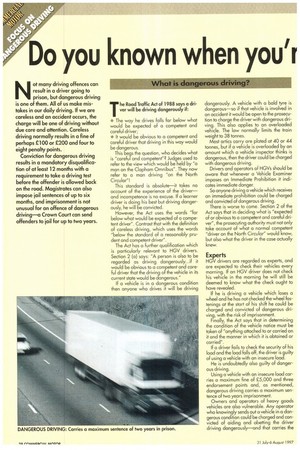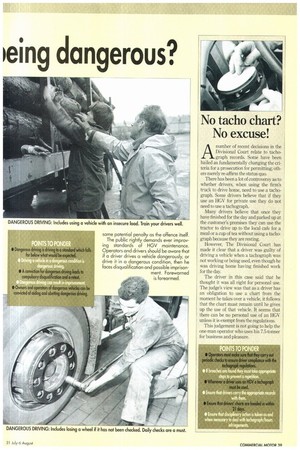Do you known when you'r
Page 40

Page 41

If you've noticed an error in this article please click here to report it so we can fix it.
leing dangerous?
What is dangerous drhig? 11111.1
Not many driving offences can result in a driver going to prison, but dangerous driving is one of them. All of us make mistakes in our daily driving. If we are careless and an accident occurs, the charge will be one of driving without due care and attention. Careless driving normally results in a fine of perhaps £100 or E200 and four to eight penalty points.
Conviction for dangerous driving results in a mandatory disqualification of at least 12 months with a requirement to take a driving test before the offender is allowed back on the road. Magistrates can also impose jail sentences of up to six months, and imprisonment is not unusual for an offence of dangerous driving—o Crown Court can send offenders to jail for up to two years. The Road Traffic Act of 1988 says a driver will be driving dangerously if:
• The way he drives falls far below what would be expected of a competent and careful driver; • It would be obvious to a competent and careful driver that driving in this way would be dangerous. This begs the question, who decides what is "careful and competent"? Judges used to refer to the view which would be held by "a man on the Clapham Omnibus". They now refer to a man driving "on the North Circular"!
This standard is absolute—it takes no account of the experience of the driver— and incompetence is no excuse. If a learner driver is doing his best but driving dangerously, he will be convicted. However, the Act uses the words "far below what would be expected of a competent driver". Contrast that with the definition of careless driving, which uses the words "below the standard of a reasonably prudent and competent driver".
The Act has a further qualification which is particularly relevant to HGV drivers. Section 2 (a) says: "A person is also to be regarded as driving dangerously...if it would be obvious to a competent and careful driver that the driving of the vehicle in its current state would be dangerous.',
If a vehicle is in a dangerous condition then anyone who drives it will be driving
dangerously. A vehicle with a bald tyre is dangerous—so if that vehicle is involved in an accident it would be open to the prosecution to charge the driver with dangerous driving. This also applies to an overloaded vehicle. The law normally limits the train weight to 38 tonnes.
Most artics carry are plated at 40 or 44 tonnes, but if a vehicle is overloaded by an amount which a vehicle inspector thinks is dangerous, then the driver could be charged with dangerous driving. Drivers and operators of HGVs should be aware that whenever a Vehicle Examiner imposes an Immediate Prohibition it indicates immediate danger. So anyone driving a vehicle which receives an immediate prohibition could be charged and convicted of dangerous driving. There is worse to come. Section 2 of the Act says that in deciding what is "expected of or obvious to a competent and careful driver", the prosecuting authority must not only take account of what a normal competent "driver on the North Circular" would know, but also what the driver in the case actually knew.
Experts
HGV drivers are regarded as experts, and are expected to check their vehicles every morning. If an HGV driver does not check his vehicle in the morning he will still be deemed to know what the check ought to have revealed.
If he is driving a vehicle which loses a wheel and he has not checked the wheel fastenings at the start of his shift he could be charged and convicted of dangerous driving, with the risk of imprisonment. Finally, the Act says that in determining the condition of the vehicle notice must be taken of "anything attached to or carried on it and the manner in which it is obtained or carried".
If a driver fails to check the security of his load and the load falls off, the driver is guilty of using a vehicle with an insecure load. He is undoubtedly also guilty of dangerous driving. Using a vehicle with an insecure load carries a maximum fine of £5,000 and three endorsement points and, as mentioned, dangerous driving carries a maximum sentence of two years imprisonment. Owners and operators of heavy goods vehicles are also vulnerable. Any operator who knowingly sends out a vehicle in a dangerous condition could be charged and convicted of aiding and abetting the driver driving dangerously—and that carries the




































































































